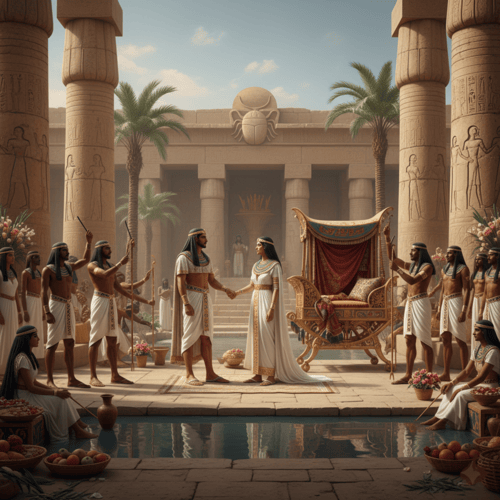Historical Accuracy of Daniel: Validation from Archaeology
For centuries, scholars and skeptics have debated the historical accuracy of the Book of Daniel. Recent archaeological discoveries and historical research shed new light on this ancient text, providing compelling evidence for its historical reliability. This comprehensive analysis examines the archaeological and historical evidence that supports the authenticity of Daniel’s account.
Nebuchadnezzar’s Babylon: Archaeological excavations have unearthed Nebuchadnezzar’s palace, where many events in Daniel likely took place. The famous Ishtar Gate and Processional Way, mentioned indirectly in Daniel’s accounts, demonstrate the exact architectural features described in the biblical narrative. Nebuchadnezzar’s building projects, documented in Daniel 4:30, find precise correlation with archaeological records and inscriptions. The discovery of the Nebuchadnezzar Chronicle provides independent confirmation of many events mentioned in Daniel. These clay tablets detail Nebuchadnezzar’s campaigns against Jerusalem, aligning perfectly with Daniel’s timeline of events.
Belshazzar: From “Historical Fiction” to Confirmed Fact: One of the most striking validations of Daniel’s historical accuracy comes from the discovery of Belshazzar’s existence. Critics once cited this as a major error in Daniel, claiming no such king existed. However, cuneiform tablets discovered in the 19th century revealed Belshazzar served as co-regent during his father Nabonidus’s absence, exactly as Daniel suggests.
Cultural Accuracy: A Window into Ancient Babylon: Archaeological evidence confirms:
- Training for royal service (Daniel 1:5): Clay tablets discovered in Babylon detail the extensive education system for court officials, including a standardised three-year curriculum. This program, as described in Daniel, included instruction in languages, literature, and court protocol—elements confirmed by discovered training texts from the Neo-Babylonian period.
- Babylonian dietary customs and wine consumption: Royal food allocation tablets excavated from Nebuchadnezzar’s palace confirm the exact types of foods and wines mentioned in Daniel’s account. Administrative records show students in the royal academy received daily portions from the king’s provisions, as described in Daniel 1:5.
- Change of names for foreign officials: Numerous Babylonian administrative documents confirm the practice of giving Babylonian names to foreign officials serving in the court. The pattern of name changes in Daniel (such as Daniel to Belteshazzar) follows the exact linguistic and theological patterns found in other contemporary Babylonian texts.
- Hierarchy in Babylon’s government: Administrative tablets from Babylon reveal a complex governmental structure that precisely matches Daniel’s descriptions of various officials and their roles. The titles mentioned in Daniel, such as the “chief of the magicians” (Rab-mag) and “chief of the eunuchs,” have been found in multiple cuneiform texts, confirming their historical accuracy. Recent discoveries have also validated the three-tiered administrative structure mentioned in Daniel 6.
- Administrative Systems and Court Protocol: Recent discoveries have confirmed Daniel’s accurate description of Babylonian and Persian administrative systems. The text’s reference to specific titles and positions, once questioned, now finds support in contemporary administrative texts from both empires.
Linguistic Evidence: Dating and Authenticity Imperial Aramaic was the official language of international communication during the Persian Empire’s height in the sixth century BC. Comparative analysis with Aramaic documents from Elephantine and other sixth-century sources shows remarkable similarities in vocabulary, syntax, and grammatical constructions that would be difficult to replicate in a later period.
- Persian loan words appear in historically appropriate contexts: The Persian loan words found in Daniel appear exclusively in administrative and governmental contexts, exactly as would be expected in a document from the early Persian period when these terms first entered common usage. Archaeological discoveries of contemporary administrative texts show these same Persian terms being incorporated into Aramaic documents during this period, with identical meanings and contexts as found in Daniel.
- The limited number of Greek terms aligns with known trade patterns: The presence of only three Greek terms in Daniel—all names of musical instruments—precisely matches the limited Greek cultural influence known to exist in Babylon through trade and diplomatic contacts during the sixth century BC. Archaeological evidence from Mediterranean trade routes and discovered musical artefacts confirm Greek musical instruments and their names had indeed reached Babylon by this period, while other aspects of Greek culture remained largely unknown.
Manuscript Evidence: The discovery of Daniel manuscripts among the Dead Sea Scrolls, dating to the second century BC, demonstrates the text’s existence well before the Maccabean period, when skeptics often claim it was written.
Prophetic Accuracy and Historical Detail: Daniel’s prophecies demonstrate remarkable historical accuracy in predicting:
- The rise and fall of empires: The sequence of empires detailed in Daniel 2 and 7 precisely matches the historical succession of Babylonian, Medo-Persian, Greek, and Roman empires, with specific details about their characteristics and transitions of power. Archaeological records, including the Nabonidus Chronicle and the Cyrus Cylinder, confirm the exact manner in which Babylon fell to the Medes and Persians, matching Daniel’s preview of these events. The detailed description of the Greek empire’s division into four parts following Alexander’s death (Daniel 8:21-22) aligns with historical records of the empire’s partition among Cassander, Lysimachus, Seleucus, and Ptolemy.
- Political developments in the ancient Near East: Daniel’s predictions about the political relationships between the Ptolemaic and Seleucid kingdoms (Daniel 11) have been confirmed in remarkable detail by historical documents and archaeological findings. The prophetic descriptions of political alliances, conflicts, and territorial disputes match the documented history of these kingdoms, including specific events like the marriage alliance attempted between the north and south kingdoms.
- The progression of historical events: The chronological framework presented in Daniel’s prophecies accurately predicted major historical milestones, including the timing of Persian kings, Alexander’s conquest, and subsequent political developments. Archaeological discoveries, including dated administrative tablets and royal inscriptions, have confirmed the timeline of events exactly as described in Daniel’s visions.
Recent Archaeological Discoveries: Modern archaeological work continues to support Daniel’s historical accuracy:
- Administrative tablets mentioning Daniel’s contemporary officials: Recent excavations in the ruins of ancient Babylon have yielded numerous clay tablets that mention officials from the Book of Daniel. The Nebo-Sarsekim Tablet, discovered among the British Museum’s collection of Babylonian cuneiform tablets, records a gold transaction made by an official named Nebo-Sarsekim who served as Nebuchadnezzar’s chief eunuch, who parallels the figure in Daniel 1:3. He appears also in Jeremiah 39:3 as one of Nebuchadnezzar’s high-ranking officers present at the fall of Jerusalem in 587 BC, with his exact title and position matching the tablet’s description. The remarkable discovery of this tablet, dated precisely to 595 BC (Nebuchadnezzar’s 10th year), demonstrates the historical reliability of both Jeremiah’s and Daniel’s accounts of the Babylonian court.
- Architectural findings confirming palace descriptions: Excavations of Nebuchadnezzar’s palace reveal the exact architectural features described in Daniel, including the elevated throne room where Babylonian kings would have conducted court business and the specific layout of the palace courts mentioned in the narrative. The discovery of the palace’s famous throne room with its massive walls covered in blue-glazed tiles matches Daniel’s descriptions of the opulence of Babylonian royal architecture. Recent ground-penetrating radar studies have also revealed additional structures that align with Daniel’s account of the palace complex.
- New evidence for Median-Persian cooperation as in Daniel’s account: Archaeological discoveries at Ecbatana, the ancient Median capital, have provided new evidence for the complex political relationship between the Medes and Persians during the trDanielansition period described in Daniel. Recent findings of administrative seals and documents demonstrate a period of joint Median-Persian rule that aligns with Daniel’s account of Darius the Mede, resolving what was once considered a historical discrepancy.
Conclusion: The Weight of Evidence The cumulative evidence from archaeology, historical records, and linguistic analysis strongly supports the historical accuracy of the Book of Daniel. While some questions remain, the overwhelming majority of Daniel’s historical claims have found remarkable confirmation through modern discoveries. This convergence of evidence demonstrates why the Book of Daniel remains a crucial historical source for understanding the Neo-Babylonian and Persian periods, while also serving as a testament to the reliability of ancient biblical texts.
Related FAQs
How do archaeological discoveries support the historical accuracy of the Book of Exodus? Archaeology has revealed evidence of Semitic peoples living in ancient Egypt and documents describing conditions similar to those depicted in Exodus. The discovery of the Ipuwer Papyrus describes events remarkably similar to the biblical plagues, including the Nile turning to blood and widespread death throughout Egypt. Additionally, archaeological findings at sites like Jericho, Hazor, and other Canaanite cities show evidence of destruction layers dating to the general period of the Israelite conquest, though scholarly debate continues about precise dating and interpretation of these findings.
What historical evidence exists for King David and Solomon’s kingdom? The discovery of the Tel Dan Stele in 1993 provided the first historical evidence outside the Bible mentioning the “House of David,” confirming David’s dynasty as a historical reality. Archaeological excavations in Jerusalem have uncovered massive structures from the 10th century BC, including the Stepped Stone Structure and large public buildings that align with descriptions of Solomon’s building projects. The recent discovery of copper mines at Timna, dated to Solomon’s era, also supports biblical accounts of his kingdom’s wealth and industrial capabilities, though scholars continue to debate the exact extent of his empire.
How accurate is the Book of Genesis in describing ancient Mesopotamian culture and customs? The Book of Genesis demonstrates remarkable accuracy in its portrayal of ancient Near Eastern customs, particularly in its descriptions of marriage customs, trade practices, and legal conventions. The Nuzi tablets, dating from around 1500 BC, confirm numerous social customs described in Genesis, including the practice of a barren wife providing a servant to bear children (as with Sarah and Hagar) and the importance of household gods in inheritance rights (as with Rachel and Laban). Clay tablets from Mari and other Mesopotamian sites also confirm the accuracy of Genesis in describing prices, marriage dowries, and covenant-making ceremonies of the patriarchal period.
What historical evidence supports the accounts in the Books of Kings and Chronicles? Numerous archaeological discoveries have confirmed specific details mentioned in Kings and Chronicles, including the existence of various mentioned monarchs, building projects, and military campaigns. The discovery of artifacts like the Black Obelisk of Shalmaneser III (which depicts Jehu, king of Israel, paying tribute), the Taylor Prism (describing Sennacherib’s siege of Jerusalem during Hezekiah’s reign), and various royal seals bearing names of biblical figures provide strong extra-biblical confirmation of these historical accounts. The Books’ descriptions of international relations, military tactics, and administrative practices have been consistently validated by archaeological findings.
How historically accurate are the Old Testament prophetic books in their descriptions of ancient nations and events? The prophetic books demonstrate remarkable accuracy in their descriptions of ancient nations, cities, and historical events, often confirmed by archaeological discoveries and ancient texts. For instance, the description of Nineveh’s fall in Nahum has been confirmed by Babylonian chronicles and archaeological evidence, while Jeremiah’s prophecies about Egypt’s defeat at Carchemish have been validated by both Babylonian and Egyptian records. Recent archaeological discoveries continue to confirm specific details mentioned by various prophets, including trade routes, cultural practices, and political alliances, though interpretation of prophetic imagery and symbolism remains a matter of scholarly discussion.
Our Related Posts
- Why Do We Affirm the Bible’s Reliability? Five Compelling Reasons
- Divine Fingerprints on Ancient Parchment—The Dead Sea Scrolls
- Connecting the Dots: Coincidences Affirm Bible Reliability
- Archaeology Endorses Scripture: Papyri and Dead Sea Scrolls
- New Testament Reliability: Debunking Myths and Lies
- Archaeological Finds Validate Bible: Unearthing Biblical Truth
Editor's Pick

Did Joseph Sin in Marrying an Egyptian?
It’s a troubling question: if God forbade His people from foreign alliances, why was Joseph’s marriage to an Egyptian not [...]

Jacob’s Ladder: How Jesus Bridges Earth and Heaven
THE GOSPEL IN GENESIS 28... A stairway to heaven—humanity has always dreamt of one since the Fall. Every religion offers [...]

In the World But Not Of It: What John 17:14-16 Really Means
Scrolling through social media, we’re bombarded by voices shouting for our allegiance—politics, trends, ideologies. As Christians, we feel the tension: [...]

Is Molinism Biblical? Reformed Challenges to Middle Knowledge
In a world craving autonomy, does God truly reign supreme, or does He negotiate with human choices? The question lies [...]

Does the Bible Teach Purgatory? Scripture’s Clear Answer
Imagine standing at the very edge of eternity, wondering if the soul requires further cleansing before you enter heaven's gates. [...]

David Danced Before the Lord—Why Don’t Reformed Churches?
When we read about King David leaping and dancing before the Lord “with all his might” (2 Samuel 6:14), a [...]

Faithful to the Pattern: Why Paul Reserves Ordination for Men
Few topics in contemporary Christianity generate more tension than women’s ordination. This question touches real lives, genuine callings, and deeply [...]

‘Flee Sexual Sin’: Why Does Paul Single This Sin Out?
When the apostle Paul writes to the Corinthian church, he doesn’t tell them to simply avoid sexual immorality or resist [...]

Does Denying God’s Sovereignty Mean Denying the Gospel?
RC Sproul once warned denying God’s sovereignty “eviscerates” grace—a strong word meaning to gut or disembowel something, leaving only an [...]

Why Christians Fast: The Biblical Discipline’s Very Real Rewards
Why would Christians, who rejoice in the good gifts of food and fellowship, deliberately choose to go without? Isn’t fasting [...]
SUPPORT US:
Feel the Holy Spirit's gentle nudge to partner with us?
Donate Online:
Account Name: TRUTHS TO DIE FOR FOUNDATION
Account Number: 10243565459
Bank IFSC: IDFB0043391
Bank Name: IDFC FIRST BANK






